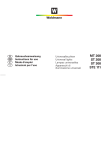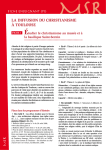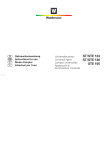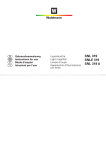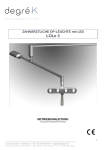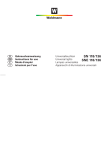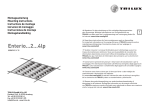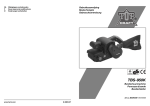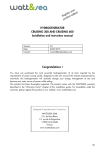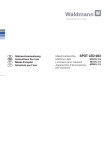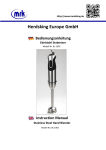Download W-GA HLC 4s.indd
Transcript
D GB F I Gebrauchsanweisung Instructions for use Mode d‘emploi Istruzioni per l‘uso Handleuchte Portable Light Lampe baladeuse Apparecchio di illuminazione portatile HLC HLCE HLWC HLWCE HLC/HLCE/HLWC/HLWCE Waldmann Original D Gebrauchsanweisung 4 Translations HLCE 107 Fig. 1 2 GB Instructions for use 8 F Mode d‘emploi 12 I Istruzioni per l‘uso 16 HLC/HLCE/HLWC/HLWCE Waldmann B HLWC 107 Fig. 2 A C Fig. 3 (HLC/HLCE) 3 Gebrauchsanweisung HLC/HLCE/HLWC/HLWCE D Waldmann Inbetriebnahme Allgemeines Bestimmungsgemäßer Gebrauch: Verwendungszweck: Handleuchte - Leuchte für den mobilen Einsatz. Einsatzort: HLC/HLCE - Nur für trockene und nicht explosionsgefährdete Räume. HLWC/HLWCE - Nur für nicht explosionsgefährdete Räume. Sicherheitshinweise : Die Leuchten HLC und HLCE dürfen nur in trockenen und nicht explosionsgefährdeten Räumen betrieben werden! Die Leuchten HLWC und HLWCE dürfen nicht in explosionsgefährdeten Räumen betrieben werden! Betriebsart: Die Leuchte ist ausgelegt für Dauerbetrieb. Abkürzungen und Symbole: Achtung, Begleitpapiere beachten! Vor Inbetriebnahme ist zu überprüfen, ob die Anschlussspannung mit der auf dem Leistungsschild angegebenen Nennspannung und Frequenz übereinstimmt. Gerät der Schutzklasse II (Schutzisolierung) Wechselstrom Netzanschluss VDE-Zulassung Die Leuchten werden üblicherweise mit Stecker bzw. Steckervorschaltgerät ausgeliefert. CEKonformitätskennzeichen Bei der Positionierung der Steckverbindung muss die Schutzklasse der Leuchte berücksichtigt werden. Die Leuchten HLCE und HLCWE werden mit freien Litzenenden geliefert. Der Hersteller kann nicht für Schäden verantwortlich gemacht werden, die infolge der Nutzung abweichend vom bestimmungsgemäßen Gebrauch, oder der Nichtbeachtung von Sicherheitshinweisen und Warnungen, verursacht werden. 4 Gebrauchsanweisung HLC/HLCE/HLWC/HLWCE D Waldmann Bedienung Wartung und Reparatur Lampenwechsel Pflege Leuchten ohne Schalter Die Standardversion der Leuchte verfügt über keinen eigenen Schalter. Zur Trennung vom Netz ist der Netzstecker abzuziehen. Vor Wartungs- und Reparaturarbeiten ist die Leuchte vom Netz zu trennen! Die Arbeiten dürfen nur von einem ausgebildeten Elektro-Fachmann ausgeführt werden! (siehe auch Fig. 3 auf Seite 3) a) Leuchte spannungslos machen (Netzstecker abziehen). b) Die beiden Verriegelungsnasen für das Schutzrohr zusammendrücken (A). c) Schutzrohr abziehen (B). d) Lampe aus Leuchtengriff herausziehen (C). e) Neue Lampe in Lampenfassung stecken. f) Schutzrohr auf Griff schieben, bis beide Verriegelungsnasen eingerastet sind. Hinweis: Das regelmäßige Reinigen von Schutzrohr und Reflektor garantiert eine höhere Lichtausbeute. Hinweis: Die wasserdichten Leuchten (HLWC und HLWCE) verfügen über keine Verriegelungsnasen. Das Schutzrohr kann mit etwas Kraft direkt aus dem Leuchtengriff gezogen werden. Entsorgung Achtung! Es dürfen nur die vom Hersteller zugelassenen Lampentypen verwendet werden (siehe „Technische Daten“). Defekte Leuchtstofflampen müssen als Sondermüll entsorgt werden. Leuchten mit Schalter Die Leuchte wird über den Wippschalter am Leuchtengriff ein- und ausgeschaltet. Positionierung Die Leuchte wird während der Benutzung an ihrem Handgriff gehalten. Sie kann auch auf einer Fläche abgelegt, oder - mittels des angebrachten Drahtbügels - aufgestellt oder aufgehängt werden. Steckverbindung und Steckervorschaltgeräte müssen so positioniert werden, dass keine Gefahr von ihnen ausgehen kann. Bei Steckervorschaltgeräten beachten Sie deren Schutzart (siehe Hinweis am Steckervorschaltgerät). Die Netzleitung muss regelmäßig auf Beschädigungen überprüft werden! Eine defekte Netzleitung darf nur vom Hersteller ausgetauscht werden! Als Ersatzteile dürfen nur vom Hersteller freigegebene Teile verwendet werden. Zur Reinigung der Leuchtenteile verwenden Sie ein mit normalem Haushaltsreiniger getränktes Tuch. Beachten Sie bei den verwendeten Mitteln die Verträglichkeit mit Lacken und Kunststoffen. Die Leuchte muss nach Ende der Lebensdauer, entsprechend den örtlichen Vorschriften, entsorgt werden. Es ist darauf zu achten, dass das Kabel so verlegt wird, dass dieses nicht beschädigt werden kann. 5 Gebrauchsanweisung HLC/HLCE/HLWC/HLWCE D Waldmann Technische Daten Allgemeine Daten Nennspannung HLC 230 V ~ Nennspannung HLCE 24 V ~ Nennspannung HLWC 230 V ~ Nennspannung HLWCE 24 V ~ Frequenzbereich 50 Hz Beachten Sie das Leistungsschild auf der Leuchte und/oder am Steckervorschaltgerät! Klassifizierung: - Schutzklasse II - Schutzart HLC IP20 - Schutzart HLCE IP20 - Schutzart HLWC IP67 - Schutzart HLWCE IP67 - nicht für explosionsgefährdete Räume geeignet Betriebsart: Dauerbetrieb Technische Sicherheitsprüfung: nach EN 60598-1 EN 60598-8 HLC 107 HLCE 107 HLWC 107 Abmessung Leuchtenkörper ca. 174 x 50 x 40 mm Abmessung Leuchtenkörper ca. 174 x 50 x 40 mm Abmessung Leuchtenkörper ca. 165 x 50 x 40 mm Stromaufnahme Leistungsfaktor Stromaufnahme Leistungsfaktor Stromaufnahme Leistungsfaktor 0,18 A 0,29 0,18 A 0,29 Steckervorschaltgerät Kompakt-Leuchtstofflampe TC-S 7W Integriert. elektron. Vorschaltgerät Kompakt-Leuchtstofflampe TC-SL 7W Steckervorschaltgerät Kompakt-Leuchtstofflampe TC-S 7W HLC 109 HLCE 109 HLWC 109 Abmessung Leuchtenkörper ca. 205 x 50 x 40 mm Abmessung Leuchtenkörper ca. 205 x 50 x 40 mm Abmessung Leuchtenkörper ca. 195 x 50 x 40 mm Stromaufnahme Leistungsfaktor Stromaufnahme Leistungsfaktor Stromaufnahme Leistungsfaktor 0,17 A 0,33 0,56 A 0,73 0,17 A 0,33 Steckervorschaltgerät Kompakt-Leuchtstofflampe TC-S 9W Integriert. elektron. Vorschaltgerät Kompakt-Leuchtstofflampe TC-SL 9W Steckervorschaltgerät Kompakt-Leuchtstofflampe TC-S 9W HLC 111 HLCE 111 HLWC 111 Abmessung Leuchtenkörper ca. 274 x 50 x 40 mm Abmessung Leuchtenkörper ca. 274 x 50 x 40 mm Abmessung Leuchtenkörper ca. 265 x 50 x 40 mm Stromaufnahme Leistungsfaktor Stromaufnahme Leistungsfaktor Stromaufnahme Leistungsfaktor 0,17 A 0,38 Steckervorschaltgerät Kompakt-Leuchtstofflampe TC-S 11W 6 0,47 A 0,73 0,70 A 0,75 Integriert. elektron. Vorschaltgerät Kompakt-Leuchtstofflampe TC-SL 11W 0,17 A 0,38 Steckervorschaltgerät Kompakt-Leuchtstofflampe TC-S 11W Gebrauchsanweisung HLC/HLCE/HLWC/HLWCE D Waldmann Technische Daten (Fortsetzung) HLWCE 107 Weitere Varianten Abmessung Leuchtenkörper ca. 165 x 50 x 40 mm Bei Bedarf wird diese Geräteserie um weitere Varianten erweitert. Abweichende technische Daten sind deshalb möglich. Achten Sie grundsätzlich auf die auf dem Leistungsschild gemachten Angaben. Stromaufnahme Leistungsfaktor 0,47 A 0,73 Integriert. elektron. Vorschaltgerät Kompakt-Leuchtstofflampe TC-SL 7W HLWCE 109 Abmessung Leuchtenkörper ca. 195 x 50 x 40 mm Stromaufnahme Leistungsfaktor 0,56 A 0,73 Integriert. elektron. Vorschaltgerät Kompakt-Leuchtstofflampe TC-SL 9W HLWCE 111 Abmessung Leuchtenkörper ca. 265 x 50 x 40 mm Stromaufnahme Leistungsfaktor 0,70 A 0,75 Integriert. elektron. Vorschaltgerät Kompakt-Leuchtstofflampe TC-SL 11W 7 Instructions for use HLC/HLCE/HLWC/HLWCE GB Waldmann General Designated use: Putting into operation Safety instructions: Abbreviations and symbols: Intended purpose: Portable light – light for mobile use. The HLC and HLCE lights must be used exclusively in dry rooms not subject to explosion hazards! Attention, take note of the accompanying documents! Place of use: HLC/HLCE - Exclusively for dry rooms not subject to explosion hazards. HLWC/HLWCE - Only suited to rooms not subject to explosion hazards. The HLW and HLWCE lights must not be used in rooms subject to explosion hazards! Protection class II unit (Protective insulation) Operating mode: The light is designed for continuous operation. Alternating current Before putting the light into operation, the user has to check whether the mains voltage is identical to the rated voltage and frequency specified on the rating plate. Mains connection VDE Approval The lights are usually supplied with shockproof plug or plug ballast unit. CE Conformity mark Strictly observe the protection class of the light when positioning the plug connection. The HLCE and HLCWE are supplied with free strand ends. The manufacturer cannot be held liable for damage caused by using the unit for purposes contrary to the designated use or by ignoring safety instructions and warnings. 8 Instructions for use HLC/HLCE/HLWC/HLWCE GB Waldmann Operation Maintenance and repairs Replacing the lamp Care Lights without switch The standard equipment of the light does not include a switch of its own. Unplug the unit to disconnect it from the mains. Disconnect the light from the mains before carrying out any maintenance or repair work! This work may only be carried out by a trained electrician! Note: Cleaning the transparent shade regularly guarantees a higher luminous efficiency. Lights with switch The light is switched on/off via the rocker switch on the light handle. The mains line must be checked regularly for damage. A defective mains cable may only be replaced by the manufacturer! (see also Fig. 3 on page 3) a) Disconnect the light (pull mains plug). b) Press the two locking pins for the protective tube together (A). c) Pull off the protective tube (B): d) Pull the lamp out of the lamp handle (C). e) Insert new lamp into the lamp socket. f) Slide protective tube on the handle till the two locking pins engage. Note: The water-proof lights (HLWC and HLWCE) do not contain any locking pins. The protective tube can be pulled off directly from the light handle using a little bit of force. Disposal Caution! Use only lamp types approved by the manufacturer (see “Technical data”). Defective fluorescent lamps must be disposed of as special waste. Positioning During use, the light is held by its handle. It may be deposited on a surface or placed upright or suspended by means of the attached strap. The plug connector and plug ballast unit must be positioned in such a way that they do not represent a risk. When using plug ballast units, please take note of the protection type (see notes on plug ballast unit). Only parts approved by the manufacturer may be used as spare parts. Please use a cloth impregnated with a suitable household cleaning agent to clean the light components. Please ensure that the cleaning agent used does not damage paints and plastics. The light must be disposed of in accordance with the local regulations when it has reached the end of its useful life. Make sure that the cable is laid in such a way that it cannot be damaged. 9 Instructions for use HLC/HLCE/HLWC/HLWCE GB Waldmann Technical data General data HLC 107 HLCE 107 HLWC 107 Nominal voltage HLC 230 V ~ Nominal voltage HLCE 24 V ~ Nominal voltage HLWC 230 V ~ Nominal voltage HLWCE 24 V ~ Frequency range 50 Hz Please take note of the rating plate on the light and/or the plug ballast unit! Dimensions of light body approx. 174 x 50 x 40 mm Dimensions of light body approx. 174 x 50 x 40 mm Dimensions of light body approx. 165 x 50 x 40 mm Power consumption: Power factor Power consumption Power factor Power consumption Power factor Classification: - Protection class II - HLC protection type IP20 - HLCE protection type IP20 - HLWC protection type IP67 - HLWCE protection type IP67 - not suitable for rooms subject to explosion hazards Operating mode: Continuous operation Technical safety check: according to EN 60598-1 EN 60598-8 0.18 A 0.29 0.18 A 0.29 Plug ballast unit Compact fluorescent lamp TC-S 7W Integrated electronic ballast unit Compact fluorescent lamp TC-SL 7W Plug ballast unit Compact fluorescent lamp TC-S 7W HLC 109 HLCE 109 HLWC 109 Dimensions of light body approx. 205 x 50 x 40 mm Dimensions of light body approx. 205 x 50 x 40 mm Dimensions of light body approx. 195 x 50 x 40 mm Power consumption: Power factor Power consumption Power factor Power consumption Power factor 0.17 A 0.33 0.56 A 0.73 0.17 A 0.33 Plug ballast unit Compact fluorescent lamp TC-S 9W Integrated electronic ballast unit Compact fluorescent lamp TC-SL 9W Plug ballast unit Compact fluorescent lamp TC-S 9W HLC 111 HLCE 111 HLWC 111 Dimensions of light body approx. 274 x 50 x 40 mm Dimensions of light body approx. 274 x 50 x 40 mm Dimensions of light body approx. 265 x 50 x 40 mm Power consumption: Power factor Power consumption Power factor Power consumption Power factor 0.17 A 0.38 Plug ballast unit Compact fluorescent lamp TC-S 11W 10 0.47 A 0.73 0.70 A 0.75 Integrated electronic ballast unit Compact fluorescent lamp TC-SL 11W 0.17 A 0.38 Plug ballast unit Compact fluorescent lamp TC-S 11W Instructions for use HLC/HLCE/HLWC/HLWCE GB Waldmann Technical data(continued) HLWCE 107 Further variants Dimensions of light body approx. 165 x 50 x 40 mm If required, this series of devices will be supplemented by further variants. The technical data may therefore be subject to modifications. Always observe the indications given on the rating plate. Power consumption Power factor 0.47 A 0.73 Integrated electronic ballast unit Compact fluorescent lamp TC-SL 7W HLWCE 109 Dimensions of light body approx. 195 x 50 x 40 mm Power consumption Power factor 0.56 A 0.73 Integrated electronic ballast unit Compact fluorescent lamp TC-SL 9W HLWCE 111 Dimensions of light body approx. 265 x 50 x 40 mm Power consumption Power factor 0.70 A 0.75 Integrated electronic ballast unit Compact fluorescent lamp TC-SL 11W 11 Mode d’emploi HLC/HLCE/HLWC/HLWCE F Waldmann Généralités Utilisation conforme à l’emploi prévu : Application : Baladeuse – lampe portative. Lieu d’application : HLC/HLCE - Uniquement dans les locaux secs et exempts de risques d’explosion. HLWC/HLWCE - Uniquement prévu pour des locaux exempts de risques d’explosion. Mise en service Consignes de sécurité : Abréviations et symboles : Les lampes HLC et HLCE ne doivent être utilisées que dans des locaux secs et exempts de risques d’explosion ! Attention, tenir compte des documents d’accompagnement ! Les lampes HLWC et HLWCE ne doivent être utilisées que dans des locaux exempts de risques d’explosion ! Type de fonctionnement : Le luminaire est conçu pour le fonctionnement en service continu. Appareil de la classe de protection II (double isolation) Courant alternatif Homologation VDE Sigle de conformité CE Avant la mise en service, s’assurer que la tension d’alimentation corresponde à la tension nominale et à la fréquence indiquées sur la plaque signalétique. Raccordement au secteur En règle générale, les lampes sont livrées avec une fiche ou un ballast électronique enfichable. Lors de la connection, il est absolument nécessaire de prendre en considération la classe de protection du luminaire. Les lampes HLCE et HLCWE sont livrées avec des extrémités de fils dénudés. Le fabricant décline toute responsabilité concernant les dommages qui résulteraient d’une utilisation non conforme à l’emploi prévu ou du non-respect des consignes de sécurité et des avertissements. 12 Mode d’emploi HLC/HLCE/HLWC/HLWCE Utilisation Lampe sans interrupteur La version standard de la lampe n’est pas équipée d’interrupteur. Pour déconnecter l’appareil du réseau, retirer la fiche. Lampe avec interrupteur La lampe s’allume ou s’éteint par l’interrupteur monté sur la poignée. Positionnement Pendant l’utilisation, la lampe est tenue par la poignée. Elle peut être posée sur une surface, positionnée à l’aide de l’étrier métallique ou accrochée. Le connecteur et les ballasts électroniques enfichables doivent être positionnés de sorte à ne présenter aucun danger.Tenir compte du type de protection des ballasts électroniques enfichables (voir indication figurant sur le ballast électronique enfichable). Veiller à ce que le câble soit posé de sorte à ne pas pouvoir être endommagé. F Waldmann Maintenance et réparation Remplacement du tube fluorescent Déconnecter le luminaire du secteur avant toute opération de maintenance ou de réparation ! Les travaux ne doivent être effectués que par un électricien qualifié formé! (voir aussi fig. 3 à la page 3) a) Déconnecter la lampe (débrancher la fiche de secteur). b) Serrer (A) les deux ergots de verrouillage du tube de protection. c) Retirer le tube de protection (B). d) Retirer le tube de la poignée de la lampe (C). e) Insérer le tube neuf dans la douille. f) Pousser le tube de protection sur la poignée jusqu’à ce que les deux ergots de verrouillage soient encliquetés. Vérifier régulièrement si le cordon est endommagé ! Un cordon d’alimentation endommagé ne doit être remplacé que par le fabricant ! Seul l’emploi de pièces de rechange agrées par le fabricant est autorisé. Remarque : Les lampes étanches (HLWC et HLWCE) ne sont pas équipées d’ergots de verrouillage. Le tube de protection peut être retiré de la poignée de la lampe en appliquant une légère force. Entretien Remarque : Un nettoyage régulier du tube de protection et du réflecteur assure un meilleur rendement lumineux. Pour nettoyer les éléments du luminaire, utiliser un chiffon imbibé d’un produit ménager usuel. Assurez-vous que les produits utilisés sont compatibles avec les laques et les plastiques. Elimination Au terme de sa durée de vie, la lampe doit être éliminée conformément aux dispositions locales. Les tubes fluorescents défectueux doivent être éliminés en tant que déchets spéciaux. Attention !Seuls les modèles de tubes agréés par le fabricant doivent être utilisés (voir « Données techniques »). 13 Mode d’emploi HLC/HLCE/HLWC/HLWCE F Waldmann Données techniques Données générales HLC 107 HLCE 107 HLWC 107 Tension nominale HLC 230 V ~ Tension nominale HLCE 24 V ~ Tension nominale HLWC 230 V ~ Tension nominale HLWCE 24 V ~ Gamme de fréquences 50 Hz Observez les indications figurant sur la plaquette signalétique de la lampe et/ou du ballast électronique enfichable ! Dimension corps de la lampe env. 174 x 50 x 40 mm Dimension corps de la lampe env. 174 x 50 x 40 mm Dimension corps de la lampe env. 165 x 50 x 40 mm Consommation électrique 0,18 A Facteur de puissance 0,29 Consommation électrique 0,47 A Facteur de puissance 0,73 Consommation électrique 0,18 A Facteur de puissance 0,29 Ballast électronique enfichable Tube fluorescent compact TC-S 7W Ballast électronique intégré Tube fluorescent compact TC-SL 7W Ballast électronique enfichable Tube fluorescent compact TC-S 7W Classification : - Classe de protection - Indice protection HLC - Indice protection HLCE - Indice protection HLWC - Indice protection HLWCE - Non prévu pour locaux à atmosphère explosive HLC 109 HLCE 109 HLWC 109 Dimension corps de la lampe env. 205 x 50 x 40 mm Dimension corps de la lampe env. 205 x 50 x 40 mm Dimension corps de la lampe env. 195 x 50 x 40 mm Consommation électrique 0,17 A Facteur de puissance 0,33 Consommation électrique 0,56 A Facteur de puissance 0,73 Consommation électrique 0,17 A Facteur de puissance 0,33 Ballast électronique enfichable Tube fluorescent compact TC-S 9W Ballast électronique intégré Tube fluorescent compact TC-SL 9W Ballast électronique enfichable Tube fluorescent compact TC-S 9W HLC 111 HLCE 111 HLWC 111 Dimension corps de la lampe env. 274 x 50 x 40 mm Dimension corps de la lampe env. 274 x 50 x 40 mm Dimension corps de la lampe env. 265 x 50 x 40 mm Consommation électrique 0,17 A Facteur de puissance 0,38 Consommation électrique 0,70 A Facteur de puissance 0,75 Consommation électrique 0,17 A Facteur de puissance 0,38 Ballast électronique enfichable Tube fluorescent compact TC-S 11W Ballast électronique intégré Tube fluorescent compact TC-SL 11W Ballast électronique enfichable Tube fluorescent compact TC-S 11W II IP20 IP20 IP67 IP67 Type de fonctionnement : Fonctionnement continu Contrôle technique de sécurité : selon EN 60598-1 EN 60598-8 14 Mode d’emploi HLC/HLCE/HLWC/HLWCE F Waldmann Données techniques (suite) HLWCE 107 Autres versions Dimension corps de la lampe env. 165 x 50 x 40 mm En cas de besoin, d’autres versions viennent compléter cette série d’appareils. Des caractéristiques techniques divergentes sont donc possibles. Observer toujours les indications figurant sur la plaquette signalétique. Consommation électrique 0,47 A Facteur de puissance 0,73 Ballast électronique intégré Tube fluorescent compact TC-SL 7W HLWCE 109 Dimension corps de la lampe env. 195 x 50 x 40 mm Consommation électrique 0,56 A Facteur de puissance 0,73 Ballast électronique intégré Tube fluorescent compact TC-SL 9W HLWCE 111 Dimension corps de la lampe env. 265 x 50 x 40 mm Consommation électrique 0,70 A Facteur de puissance 0,75 Ballast électronique intégré Tube fluorescent compact TC-SL 11W 15 Istruzioni per l’uso HLC/HLCE/HLWC/HLWCE I Waldmann Informazioni generali Uso conforme alla destinazione: Scopo d’impiego: Apparecchio di illuminazione portatile – lampada mobile. Luogo d’impiego: HLC/HLCE - Esclusivamente per locali asciutti e non soggetti a pericolo d’esplosione. HLWC/HLWCE - Non idoneo per locali soggetti a pericolo d’esplosione. Messa in funzione Avvertenze per la sicurezza: Gli apparecchio di illuminazione HLC e HLCE devono essere utilizzati esclusivamente in locali asciutti e non soggetti a pericolo d’esplosione! Gli apparecchio di illuminazione HLWC e HLWCE non devono essere utilizzati in locali soggetti a pericolo d’esplosione! Tipo di funzionamento: L’apparecchio d’illuminazione è predisposto al funzionamento continuo. Abbreviazioni e simboli: Attenzione, osservare la documentazione in dotazione! Apparecchio della classe di protezione II (Isolamento protettivo) Corrente alternata Omologazione VDE Contrassegno conformità CE Prima della messa in funzione occorre controllare che la tensione della rete indicata corrisponda alla tensione nominale ed alla frequenza indicate sulla targhetta. Collegamento alla rete Gli apparecchi d’illuminazione vengono forniti di standard con connettore a spina oppure con connettore con alimentatore. Effettuando il collegamento alla rete è necessario prestare attenzione alla classe di protezione dell’apparecchio di illuminazione. Gli apparechi di illuminazione HLCE e HLCWE vengono forniti senza spina. Il fabbricante non si assume la responsabilità per danni causati da un utilizzo non conforme allo scopo d’impiego previsto o della mancata osservanza delle avvertenze di sicurezza e degli avvertimenti. 16 Istruzioni per l’uso HLC/HLCE/HLWC/HLWCE I Comando Apparecchi senza interruttore La versione standard dell’apparecchio di illuminazione non dispone di un interruttore proprio. Per lo scollegamento dalla rete va staccata la spina della corrente. Fare attenzione che i cavi siano posati in modo che non possano essere danneggiati. Apparecchi con interruttore L’apparecchio di illuminazione viene inserito e disinserito mediante l’interruttore a bilico situato sull’impugnatura. Manutenzione e riparazione Posizionamento Durante il suo uso, l’apparecchio di illuminazione viene tenuto sull’impugnatura. L’apparecchio di illuminazione può essere depositato su una superficie oppure - mediante la staffa incorporata - può essere posato in piedi o appeso. Il connettore a spina ed il connettore con alimentatore devono essere posizionati in modo che non ne possano scaturire pericoli. In caso di connettori con alimentatore fare attenzione al tipo di protezione (vedi l’avvertenza sul connettore con alimentatore). Per i lavori di manutenzione e di riparazione scollegare l’apparecchio d’illuminazione dalla rete! I lavori devono essere eseguiti esclusivamente da un elettricista specializzato addestrato! La linea della rete deve essere controllata ad intervalli regolari per individuare l’eventuale presenza di danni! Linee della rete difettose devono essere sostituite esclusivamente dal costruttore! Come parti di ricambio vanno utilizzati esclusivamente componenti autorizzati dal costruttore. Waldmann Sostituzione della lampada (vedi fig. 3 a pagina 3) a) Staccare la spina per togliere tensione all’apparecchio. b) Premere i due denti di bloccaggio per il tubo di protezione (A). c) Togliere il tubo di protezione (B). d) Togliere la lampada dall’impugnatura dell’apparecchio (C). e) Inserire la nuova lampada nel portalampada. f) Spingere il tubo di protezione sull’impugnatura finché scattano in arresto entrambi i denti di bloccaggio. Avvertenza: Gli apparecchi di illuminazione ermetici all’acqua (HLWC e HLWCE) non dispongono di denti di bloccaggio. Il tubo di protezione può essere estratto dall’impugnatura tirando leggermente. Attenzione! Devono essere utilizzati esclusivamente i tipi di lampada consentiti dal costruttore (vedi “Dati tecnici”). Cura Avvertenza: Pulendo il tubo di protezione ed il riflettore ad intervalli regolari si assicura un maggiore rendimento luminoso. Per la pulizia delle parti dell’apparecchio di illuminazione fare uso di un panno imbevuto di normale detergente domestico. Assicurarsi che i prodotti utilizzati siano compatibili con le vernici e con i materiali sintetici. Smaltimento Alla fine della durata utile eliminare l’apparecchio d’illuminazione in osservanza delle prescrizioni ecologiche vigenti locali. Le lampade fluorescenti guaste vanno smaltite come rifiuti speciali. 17 Istruzioni per l’uso HLC/HLCE/HLWC/HLWCE I Waldmann Dati tecnici Dati generali HLC 107 HLCE 107 HLWC 107 Tensione nominale HLC 230 V ~ Tensione nominale HLCE 24 V ~ Tensione nominale HLWC 230 V ~ Tensione nominale HLWCE24 V ~ Gamma di frequenza 50 Hz Osservare la targhetta sull’apparecchio di illuminazione e/o sul connettore con alimentatore! Dimensioni del corpo dell’apparecchio circa 174 x 50 x 40 mm Dimensioni del corpo dell’apparecchio circa 174 x 50 x 40 mm Dimensioni del corpo dell’apparecchio circa 165 x 50 x 40 mm Corrente assorbita Fattore di potenza Corrente assorbita Fattore di potenza Corrente assorbita Fattore di potenza Classificazione: - Classe di protezione II - Tipo di protezione HLC IP20 - Tipo di protezione HLCE IP20 - Tipo di protezione HLWC IP67 - Tipo di protezione HLWCE IP67 - non adatto per locali soggetti a pericolo d’esplosione Tipo di funzionamento: continuo Servizio Controllo tecnico della sicurezza: secondo EN 60598-1 EN 60598-8 0,18 A 0,29 0,18 A 0,29 Connettore con alimentatore Lampada fluorescente compatta TC-S 7W Alimentatore elettronico integrato Lampada fluorescente compatta TC-SL 7W Connettore con alimentatore Lampada fluorescente compatta TC-S 7W HLC 109 HLCE 109 HLWC 109 Dimensioni del corpo dell’apparecchio circa 205 x 50 x 40 mm Dimensioni del corpo dell’apparecchio circa 205 x 50 x 40 mm Dimensioni del corpo dell’apparecchio circa 195 x 50 x 40 mm Corrente assorbita Fattore di potenza Corrente assorbita Fattore di potenza Corrente assorbita Fattore di potenza 0,17 A 0,33 0,56 A 0,73 0,17 A 0,33 Connettore con alimentatore Lampada fluorescente compatta TC-S 9W Alimentatore elettronico integrato Lampada fluorescente compatta TC-SL 9W Connettore con alimentatore Lampada fluorescente compatta TC-S 9W HLC 111 HLCE 111 HLWC 111 Dimensioni del corpo dell’apparecchio circa 274 x 50 x 40 mm Dimensioni del corpo dell’apparecchio circa 274 x 50 x 40 mm Dimensioni del corpo dell’apparecchio circa 265 x 50 x 40 mm Corrente assorbita Fattore di potenza Corrente assorbita Fattore di potenza Corrente assorbita Fattore di potenza 0,17 A 0,38 Connettore con alimentatore Lampada fluorescente compatta TC-S 11W 18 0,47 A 0,73 0,70 A 0,75 Alimentatore elettronico integrato Lampada fluorescente compatta TC-SL 11W 0,17 A 0,38 Connettore con alimentatore Lampada fluorescente compatta TC-S 11W Istruzioni per l’uso HLC/HLCE/HLWC/HLWCE I Waldmann Dati tecnici (continua) HLWCE 107 Ulteriori varianti Dimensioni del corpo dell’apparecchio circa 165 x 50 x 40 mm Se necessario questa serie di apparecchi viene ampliata con diverse varianti. Risultano quindi possibili differenze concernenti i dati tecnici. Osservare in linea di massima le indicazioni riportate sulla targhetta. Corrente assorbita Fattore di potenza 0,47 A 0,73 Alimentatore elettronico integrato Lampada fluorescente compatta TC-SL 7W HLWCE 109 Dimensioni del corpo dell’apparecchio circa 195 x 50 x 40 mm Corrente assorbita Fattore di potenza 0,56 A 0,73 Alimentatore elettronico integrato Lampada fluorescente compatta TC-SL 9W HLWCE 111 Dimensioni del corpo dell’apparecchio circa 265 x 50 x 40 mm Corrente assorbita Fattore di potenza 0,70 A 0,75 Alimentatore elettronico integrato Lampada fluorescente compatta TC-SL 11W 19 Best.-Nr. 405 089 810 - ©copyright H.Waldmann GmbH & Co. KG - nB/12/04 TB - Änderungen vorbehalten - Printed in Germany HLC/HLCE/HLWC/HLWCE 20 Waldmann Ausgabe: 01.12.2004




















